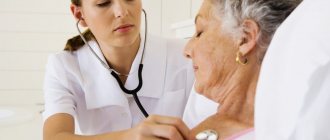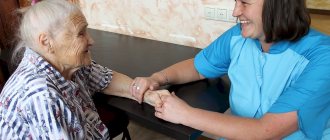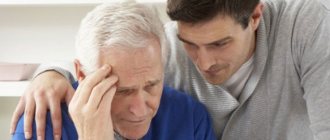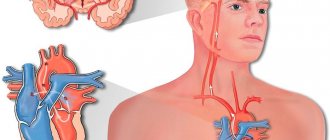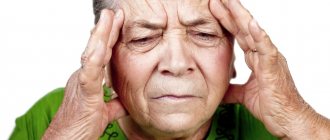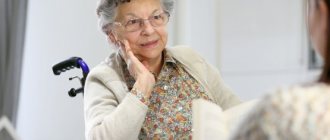13.11.2014
Maltseva Marina Arnoldovna
Head of the consultation department - neurologist, specialist in the field of extrapyramidal pathologies, doctor of the highest category
A stroke is a very complex condition that has many negative consequences for the patient’s body, significantly reduces the quality of his life, and actually completely “turns off” some important functions, for example, the ability to understand the speech of others, memory problems, etc.
However, people who have had one stroke are at serious risk of having another. Today, unfortunately, this is not uncommon. Most often, a recurrent stroke occurs unexpectedly, affecting other parts of the brain. If a person has not yet fully recovered from the first stroke, the rehabilitation period after the second will be even more difficult and slower, since the area of damage to the brain has increased.
Causes of recurrent stroke
Experts note that in approximately half of the cases, a recurrent stroke occurs due to the fact that a person ceases to consider himself sick, as a result of which he ceases to follow the recommendations of doctors. The patient, gradually returning to his normal life, stops following:
- your blood pressure;
- the condition of blood vessels;
- the condition of the heart muscle;
This is why doctors say the main reason for a recurrent stroke is neglect of one’s health.
Why is it so important to monitor all of the above indicators?
- Pressure. If for the first stroke only a sharp jump in pressure will be dangerous, then for a second stroke even a slight increase in pressure will be enough.
- Vessels. Here it is very important to carefully examine all the vessels of the brain and check for the presence of aneurysms that can “rupture”, which will lead to hemorrhage in the brain. If aneurysms are found, they must be removed immediately. No less dangerous to the health of a patient who has suffered a stroke are atherosclerotic plaques, which significantly impede the blood supply to the brain.
- Heart. It is important for the patient to undergo an ECG and exclude the possibility of blood clots. For prevention, doctors may advise the patient to take courses of blood thinning medications.
People who have suffered a stroke need to constantly monitor their blood pressure, blood cholesterol levels, and also follow the principles of a healthy diet.
WHAT IS ISCHEMIC STROKE?
An “ischemic stroke” means that blood flow through a vessel supplying the brain with oxygen and nutrients is interrupted, and the brain cells in the area where the circulation is disrupted die. In medical parlance, this is called a cerebral infarction. Due to the death of brain cells, a person loses control over the functions for which this part of the brain is responsible. The severity of these disorders depends on the location of the blood clot blocking the vessel and the diameter of the vessel that is blocked. Different areas of the brain control different brain functions, for example, if the right side of the brain is affected, weakness or paralysis of the left side of the body develops. The manifestations of a stroke depend on which area of the brain is affected. Most often, stroke affects people after 60 years of age. Every third stroke that develops is fatal. It may take 6 months or more to restore lost functions after a stroke. Many recover completely and return to work and a full life.
Signs of a recurrent stroke
Doctors note that the risk of a recurrent stroke is highest in the first year of recovery. The occurrence of a recurrent stroke can be determined by characteristic signs:
- by deterioration of vision (in some cases: blindness in one eye);
- by numbness of the limbs (in the worst case: paralysis of the limbs or half of the body);
- for digestive problems;
- by loss of consciousness;
- for impaired coordination of movements;
- for speech impairment.
Motor rehabilitation
Passive gymnastics. Motor rehabilitation of patients who have suffered a stroke is an integral and one of the most important components of the recovery process. The basic method of motor rehabilitation is physical therapy, which begins as soon as the patient’s condition allows. The objectives of physical therapy include restoration (full or partial) of range of motion, strength and dexterity in the affected limbs, balance function, and self-care skills.
In the early period, immediately after a cerebrovascular accident occurs, passive gymnastics is performed. It allows not only to normalize the tone of the limbs, but also to prevent the formation of bedsores. Passive gymnastics is performed by exercise therapy specialists together with the patient’s relatives.
When performing gymnastics, passive movements of paretic limbs are performed at a slow pace, carefully, slowly, while trying not to cause pain or increase muscle tone. Such gymnastics is first performed on the healthy side and then on the sore side. It is important to start proximally, in isolation at each joint. In this case, 8–10 movements are performed in each joint.
Active gymnastics. The next stage of recovery is the beginning of active gymnastics, which begins with simple movements of the limbs and becomes more complex as the patient becomes more active. The patient is taught to sit up in bed, maintain balance and stand up, then walk, first accompanied or with support, and then independently.
Great importance is given to motor rehabilitation in the affected upper limb, in particular the restoration of fine motor skills, which is the key to full social and everyday readaptation. The patient learns simple self-care skills, in particular eating, personal hygiene, using the toilet and bathroom, as well as dressing independently, in stages.
The duration of the various stages of motor recovery depends, first of all, on the extent of the area of brain damage. An important part of rehabilitation, both motor and psychological, is the early involvement of patients in household work and the preparation of able-bodied patients to go to work.
Massotherapy
Along with physical therapy, positioning of the lying patient and therapeutic massage are important for the recovery of the patient. The purpose of these therapeutic measures is to prevent the development of muscle contractures and maintain normal joint function, prevent bedsores and pulmonary complications, primarily congestive (hypostatic) pneumonia. When conducting massage sessions, certain principles must be observed:
- the extensor muscles are usually massaged on the arm,
- on the leg - the flexor muscles of the leg and the dorsum of the foot.
Massage is carried out throughout the entire recovery period.
Physiotherapeutic procedures, acupuncture, acupressure, cryotherapy, and water procedures are widely used as additional methods that speed up the rehabilitation process.
Consequences of a recurrent stroke
In 70% of cases, the consequences of a second stroke are much more severe than the initial one: most cases end in the death of the patient. The patient may permanently lose, for example, some intellectual abilities or mobility.
Also, the consequences of a repeated stroke include severe, irreversible changes in a large area of brain tissue.
Doctors remind that after the first stroke the patient needs to completely change his lifestyle. From now on, a person will have to constantly monitor his health, constantly record changes, adhere to a special diet and do therapeutic exercises. This should become a habit, because to minimize the risk of a recurrent stroke, at least 4-5 years of prevention are necessary.
Clinical Brain Institute Rating: 3/5 — 6 votes
Share article on social networks
Who's at risk
After a primary stroke, the body retains mechanisms that provoke the following development of events: intravascular thrombus formation, vascular atherosclerosis. The patient, as a rule, also has a number of concomitant diseases, often in advanced forms: hypertension, diabetes mellitus, arrhythmia, heart failure and others. Preventing recurrent ischemic stroke in such cases is a rather difficult task, but thanks to the efforts of qualified specialists at the Yusupov Hospital, it is feasible.
Repeated ischemic stroke sometimes threatens even patients who are unaware that they have already suffered a vascular accident: patients with short-term disturbances of cardiac or cerebral circulation, the so-called transient ischemic attacks, manifested by the sudden onset of headache, dizziness, numbness of the arm or leg - symptoms which are often ignored, despite the fact that they are the first alarm bells preceding a stroke. The threat of vascular attack increases even more with transient loss of vision, speech, weakness in the upper or lower limb, sudden amnesia and other symptoms.
In this case, the patient should not hesitate; it is recommended to seek medical help as soon as possible at the neurology clinic of the Yusupov Hospital to obtain a doctor’s consultation. You will undergo the necessary examinations: ultrasound examination of large vessels (first of all, it is necessary to examine the carotid arteries), an electrocardiogram, ECHO-CG, detailed blood tests for the lipid profile and the tendency to form blood clots, the level of homocysteine - an amino acid that causes early atherosclerosis and thrombus formation, as well as several times increasing the risk of stroke and heart attack.
A similar examination is also recommended for patients who have suffered a hypertensive crisis, attacks of angina pectoris (pain in the heart area), or arrhythmia. These conditions often precede a stroke and are manifestations of transient ischemic attacks.
Make an appointment
Programs:
Assessment of rehabilitation potential
Movement restoration
Rehabilitation after stroke
Restoration of cognitive functions
Early (resuscitation) rehabilitation
World stroke statistics
According to the above-mentioned round table meeting “Brain Stroke”, every year 5.5-6 million people in the world develop the disease, of which 4.5 million die - this is the population of a medium-sized European state.
According to the GBD (which we have also already reported on), in 2013, the number of people who suffered a stroke worldwide was 25.7 million . According to WHO information, in 2014, 6.7 million people died from acute cerebrovascular accidents in the world; the incidence of strokes for the period 2004-2014. increased from 1.5 to 5.1 cases per 1000 population (Official periodical: World Health Organization: The leading causes of death). Since 2004, this pathology has been declared a global epidemic.
The proportion of stroke patients who received treatment in a hospital, according to European registers, in the 80s of the 20th century was:
- in Sweden (Gothenburg) – 88%;
- in Denmark (Copenhagen) – 79%;
- in Ireland (Dublin) – 74%;
- in Finland (Espoo) – 70%;
- in Yugoslavia (Zagreb) - 83%;
- in Israel (Zerifin) - 75%.
In Russia during the same period, 37% of patients were hospitalized (Leningrad).
Nowadays, 93-96% of Europeans, Japanese and Americans with established stroke receive treatment in a hospital setting, and only 79.81% of Russians (information for 2010 by L. V. Stakhovskaya and colleagues).
In a number of European registries, for example, Danish, there is a dependence of the incidence of stroke on the age and gender of patients. Thus, most often primary stroke is diagnosed in men 45-59 years old and women 80 years old and older (Olsen TS, Andersen ZJ, Andersen KK, 2011).
In some countries, there has been a trend towards an increase in the incidence of stroke in children . American scientists from Ohio State University in 2011 stated that per 100 thousand children aged 1-18 years, there are 2-3 cases of acute cerebrovascular accident per year. According to other experts from the USA (A. Go, 2012, H. Fullerton, 2003, L. Morgenstern, 2010), the incidence of ischemic stroke in children under one year of age is 7.8 cases per 100 thousand population, hemorrhagic – 2.9 cases. 40% of all childhood strokes develop before the age of 1 year (F. Kirkham, A. Hogan, 2004). The overall mortality from them is on average 12%, the average risk of recurrent stroke is about 20% (E. Kramarow, H. Lentzner Rooks, 1999).
According to WHO, the mortality rate from childhood stroke in the United States is 0.6 cases per year per 100 thousand population aged 1-15 years. As for adults, the same World Health Organization claims that over the past 10 years, the incidence of strokes has increased from 1.5 to 5.1 people per 1000 population.
An international group of scientists from New Zealand and the USA (VL Feigin, CM Lawes, DA Bennet, S. Barker) analyzed 56 population-based studies regarding early (21 days to 1 month) stroke mortality, published between 1970 and 2008. The purpose of the scientific work was to study the dynamics of the incidence of acute cerebrovascular insufficiency in countries with different income levels. The findings were published in 2009 in The Lancet Neurology:
- over the past 40 years, in high-income countries (according to the World Bank), the incidence of strokes has decreased by 42%, and in low- and middle-income countries it has increased by more than 100%;
- in the period from 2000 to 2008. The incidence of strokes in economically undeveloped countries for the first time exceeded that in developed countries by 20%.
Scientists are convinced that the incidence of stroke in low- and middle-income countries must be brought under government control.
In the United States, stroke is the leading cause of disability and the 5th leading cause of death , according to the Centers for Disease Control and Prevention's 2007 Heart Disease and Stroke Statistics . Every year the disease is diagnosed in 795 thousand people. At the same time, 610 thousand have a primary one, 185 thousand have a repeat one (D. Mozaffarian, EJ Benjamin, AS Go and others, 2015). 82-92% of all diagnosed acute cerebrovascular accidents are ischemic stroke. The risk of death from stroke in African Americans is 1.49 times higher than that of their white-skinned compatriots (AT Schneider, B. Kissela, D. Woo, 2004). Hispanics are less likely to suffer from acute cerebrovascular accidents than whites and African Americans, but they are more likely to experience lacunar strokes (after which cavities are formed in the deep parts of the brain) and strokes at a young age.
In the UK, about 150 thousand cases of acute cerebrovascular accidents per year are recorded annually, the disease ranks third in the list of causes of death (BK MacDonald, OC Cockerell, SD Shorvon, 2000). The lowest mortality rate after stroke is in France, the USA and Switzerland.
In the most disadvantaged countries, the death rate from stroke is tens of times higher than in countries with a lower stroke burden. Thus, in 2010, the mortality rate from stroke in Russia was 180 people per 100 thousand population, in China - 127 people, and in the USA - 29 (VL Feigin, MH Forouzanfar and others 2010).
At the International Conference on Stroke Problems (February 18-20, 2009, San Diego, USA), the results of a large-scale study were announced that compared survival rates from strokes in 192 countries from different regions of the world. It turned out that most often people die from acute cerebrovascular accidents in eastern Europe, northern Asia, central Africa and the southern region of Oceania. in first place in terms of mortality from strokes among the countries studied (251 cases per 100 thousand population), and Kyrgyzstan is in second place (237 per 100 thousand). An honorable last place is occupied by the Republic of Seychelles (24 per 100 thousand). Some of the last places are occupied by such countries as:
- Australia – 184th place: 33 deaths from stroke per 100 thousand population;
- USA – 186th place: 32 cases per 100 thousand;
- Canada – 189th place: 27 cases per 100 thousand;
- Switzerland – 191st place: 26 cases per 100 thousand.
Approximately the same patterns were observed for the DALY (disability-adjusted life years) indicator – disability-adjusted life years. The authors of the study (SC Johnston, S. Mendis, CD Mathers) identified a clear pattern between the economic development of the country and the increasing medical and social burden of strokes in this country. This is due to the fact that low- and middle-income countries cannot afford expensive approaches to stroke prevention that require large-scale reorganization of the health service, and therefore are not able to use many of the recommendations developed by authoritative international organizations. The results of the study can be found in The Lancet Neurology, 2009.
Specialist of the Belarusian State Medical University Yu. S. Karnatsevich reports that in the last decade, morbidity and mortality from vascular lesions of the brain has been significantly reduced in Western Europe, Canada, the USA, Australia, New Zealand, Japan - every year by an average of 7% . In most countries of Eastern Europe and the CIS, on the contrary, there is an increase in the incidence of strokes of up to 13% annually. World statistics data
| A country | Incidence of stroke per 1000 people | Mortality per 1000 people | |
| Men | Women | ||
| Italy | 1,21 | 0,63 | 0,59 |
| Poland | 1,52 | 0,76 | |
| Germany | 1,36-1,67 | 0,58-1,02 | |
| Denmark | 1,77 | 0,93 | |
| Yugoslavia | 2,35 | 1,10 | 0.87 (men), 0.53 (women) |
| China | 2,40 | 1,69 | |
| Lithuania | 2,86 | 1,46 | |
| Russia | 2,51-3,44 | 1,23-2,94 | 3,00 |
| Finland | 2,64-3,59 | 1,05-1,94 | 0,64 |
| Norway | 0,55 | ||
| France | 2,30 | 0,39 | |
| Spain | No data | No data | 0,55 |
| Israel | No data | No data | 0,39 |
| Switzerland | No data | No data | 0,35 |
